Droptop Supreme: The inside story of Oldsmobile’s last convertible
It was February, 1988, and Georgia’s Doraville Assembly was filled with gleaming new Oldsmobile Cutlass Supremes. Five years and $7B had been spent on the new front-drive Cutlass and its W-body (at first “GM10”) siblings, the Buick Regal and Pontiac Grand Prix. These were boldly styled, aerodynamic, high-tech cruise missiles aimed at Ford Thunderbirds and Honda Preludes alike. Unfortunately, the car market was more interested in Mercury Sables. The early W cars were a costly swing-and-miss.
First impressions really count in the car business. They looked awesome, but the early Ws never met their over-optimistic sales projections. The sporty, high-tech image was undermined by 1988 models landing only with the 130-hp 2.8-liter V-6, an engine shared with the Chevy Cavalier.
In March of 1989, Doraville was idled for a month because of overstocked dealers. GM was also losing $1800 on every W it built. GM’s gleaming, robot-filled factories—each dedicated to a single model—couldn’t flex with demand and operated way below capacity, a symbol of Roger Smith–era dysfunction.

There was one W-body everybody seemed to love: the Oldsmobile Cutlass Supreme Convertible. Based on a small run of convertibles built for the 1988 Indy 500 pace car program, the full production version looked great and demand outstripped supply for much of its 1990–95 run. The droptop Supreme ended up being Olds’ final ragtop, and 35 years later, both the coupe and convertible have come into their own as classics. The styling still stands out.
As a car-obsessed kid, I loved the wild design of the Cutlass coupe and convertible. But I always wondered how such a radical departure from the previous Cutlasses happened. How did that convertible get made? To get the answers to those questions, I sat down (separately) with Ed Welburn, GM’s VP of global design from 2005 to 2016, and David Draper, former CEO of Cars & Concepts (C&C), who engineered and converted the cars.
In the mid-1980s, Welburn was an Oldsmobile studio staffer working under design leads John Perkins and, later, David North. While Welburn was helping shape the Cutlass and the streamlined Aerotech, Draper was designing convertibles for Chrysler and Ford as well as projects for Olds that Welburn also worked on, like the 1983 Hurst/Olds and the 1985 Cutlass Calais pace car, both projects Welburn also worked on.
“It happened that C&C was in Brighton [Michigan], right between Oldsmobile in Lansing and GM’s tech center in Warren,” Welburn said. “That made them an easy partner but they also put real quality into what they did. I recall many drives to Brighton.”
The Aero Cutlass
Work began on the W-body in 1983–84, when the “aero look” was king. Welburn credits that aesthetic to the influence of the Audi 5000 and Ford Sierra. “GM had also done concepts like that, but we’d never put anything like them into production.” As it turned out, that would soon change—possibly because CEO Roger Smith had been skewered in Fortune magazine in 1983 for the company’s “cookie cutter” cars and seeming lack of interest in design. The magazine parked four burgundy A-body sedans next to each other to hammer home the point.
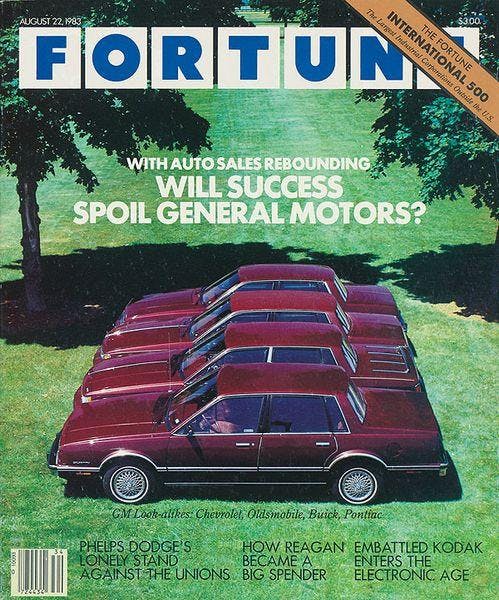
“I’d worked on the previous three Cutlasses and they were all big sellers,” Welburn said, “but the edict, from Smith directly, was that change was needed. In the studio, I did a whole lot of sketches, evolutionary and revolutionary, but when the time came to choose, the direction from the top was definitely ‘revolutionary.’”
Smith had a specific example in mind: the Aero 2000 concept car created for GM’s exhibit at Disney World’s Epcot Center. “It was a very aerodynamic, sleek-looking car, but also very small because it had to fit in the exhibit. It had a glass-to-glass roof with no conventional sail panel, which was part of our inspiration,” explained Welburn. Aside from its electroluminescent dashboard, the interior was less radical and more of an evolution of the previous car.
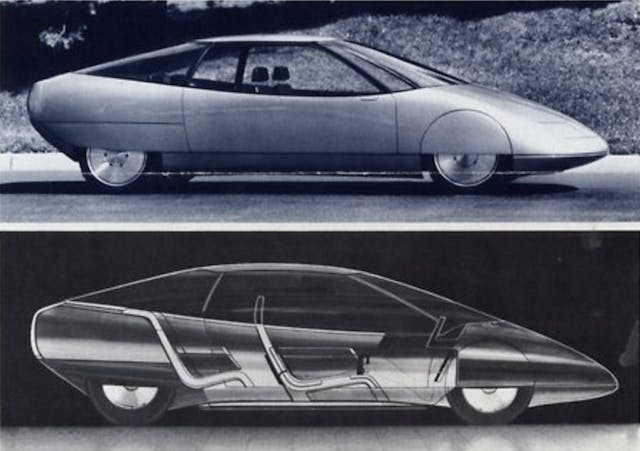
“As designers, we were all excited to work on something that cutting edge. But the whole time we were working on it, market research kept saying that this wasn’t exactly the right car for the moment.” It was, however, what leadership wanted.
Part of the issue, Welburn said, is that the market was trending away from coupes and towards sports sedans. “The Taurus really fit that bill, and we were only working on coupes.” There was a Chevy sedan in the pipeline but the other sedans didn’t arrive for two years after the coupes because they were added very late in the game. In 1988 and 1989, four-door buyers would be shown to the Cutlass Ciera, one of the Fortune cover cars.
Sure enough, Once the Cutlass arrived, it didn’t meet sales aspirations. “We got really good press and the car looked really distinctive,” but as predicted by the researchers, the lineup only having coupes to sell didn’t help the launch. Nor did the memorable but incoherent “This is not your father’s Oldsmobile” ad campaign promoting the new Supreme, which demeaned existing Olds customers while simultaneously failing to win new ones.
The pace cars
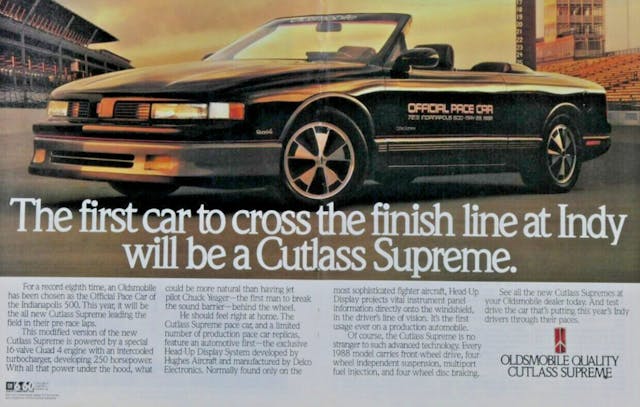
The Indy pace cars of 1988 were part of that initial marketing push, but they also had another purpose. In talking with Welburn about my own recollections of the cars, I mention my favorite NASCAR driver, Harry Gant, who famously piloted a Cutlass to four straight wins in September 1991.
“It’s funny that you mention Gant,” Welburn said. “Towards the end of the design program, we created a special fascia meant for drivers like Gant and A.J. Foyt in NASCAR, Paul Newman, and Paul Gentilozzi in IMSA, and Warren Johnson in NHRA. The car was very aerodynamic for that time, but for racing we knew it needed more of an edge, so we went into the wind tunnel and tested out an altered version of the front fascia. We homologated it by building the pace cars.”
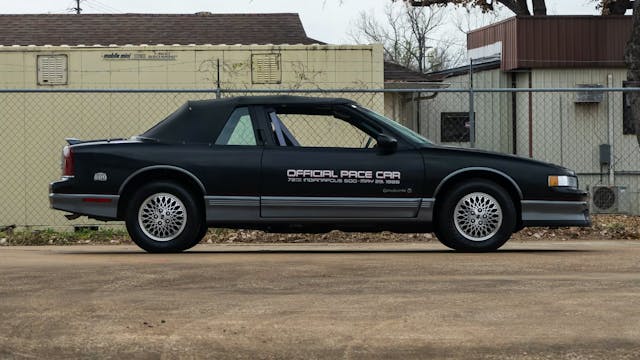
Oldsmobile turned to Cars & Concepts to build its planned 200 pace-car coupes and 50 convertibles, including the three race-use vehicles. Co-founded in 1976 by Draper, a former White Truck engineer, and a veteran of the original Hurst/Olds programs, Dick Chrysler, one of the company’s first jobs was the modifications on the 1976 Hurst/Olds. “We often worked with [Oldsmobile chief engineer] Ted Lucas back then,” Draper said. That first project led to many more.
The coupes were just a paint and trim job, while the race-day cars were repurposed development mules powered by heavily massaged Quad-4 engines and no provision for a top or exterior door handles, though they did have a super-cool Hughes Electronics head-up display. But Olds also wanted working convertibles for dealers.

A gaggle of droptops were laboriously built and later distributed to dealerships but, clarified Draper, “It was impossible to build them properly in low volume and in that time frame.” GM quickly bought most of the cars back, ostensibly because of a “certification issue,” but the exact details are unclear. Several dealers refused to part with the cars, and thus, a small number survived. Draper isn’t sure if the full run of 50 was actually finished. “I was, after all, the CEO, and focused on bigger projects.”
Though rough compared to what came later, these droptops made a big impression. “The pace car got people excited about a convertible, and that’s what really got the ball rolling [for production],” said Welburn.
The challenge of convertible conversions

At first glance, the Cutlass’ glassy roof looks like an easy starting point for a convertible adaptation … until you see the door handle on the B-pillar. “If you want to move that handle you have to retool the whole door and everything in it,” said Draper. It would have been a huge expense. “Our solution was to design a concept that retained all of the interior door mechanism and used a hoop. It was not a roll bar but a design element.”
Nor was the approach inspired by Volkswagen and the Cabriolet, he confirmed. “Some people who loved it and some people hated it.” The hoop was part of the car from the start, even on the pace car units.
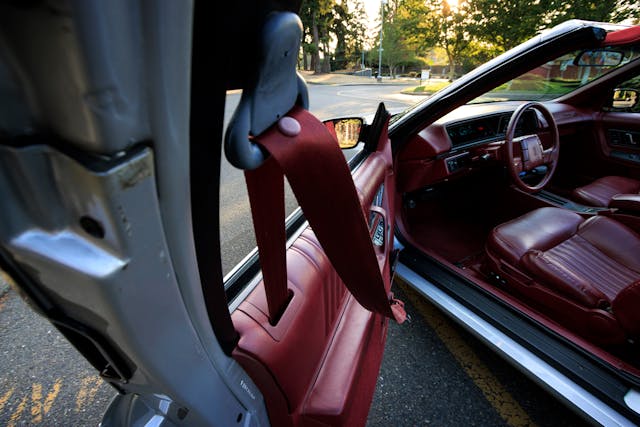
The convertible’s engineering was a 50-50 collaboration between C&C and Lucas’ engineering team at Oldsmobile. The most important part of the production conversion development, Draper said, “was convincing Oldsmobile to do all the body changes in the body in white,” the phase at which all the structural elements of the unpainted car are complete. Starting the conversion later would have also driven the price too high.
All this meant a very involved process at Doraville.

C&C pulled bare-metal coupes off the line and trucked them to a parallel shop. “There, we’d remove all the parts that weren’t necessary and add the parts that were, including rebuilding the door and strengthening the floor and rocker panels, the whole works.” The bodies were then trucked back to Doraville and inserted on the line in their original slot. “So their line kept running and so did ours.” After trimming, the cars returned to C&C’s shop for the rear seats and top.
“The system worked really well, and I think we built it to a standard we couldn’t have any other way short of building the whole body ourselves. We might’ve changed the door if we’d done that, but the car would have been unsalably expensive,” said Draper.

As it was, the production convertible was about $4500 pricier than the coupe. The hoop design was later integrated into the limited-production Chevy Beretta convertible, “which was also a pace car and also had those door handles,” Draper laughed. Logistical and crash-test hurdles prevented that one from getting built in volume.
Welburn was also pleased with how the car translated into a droptop: “I remember many afternoons working with C&C on that project making sure everything looked right. I’m not an engineer, but visually it was a good result.
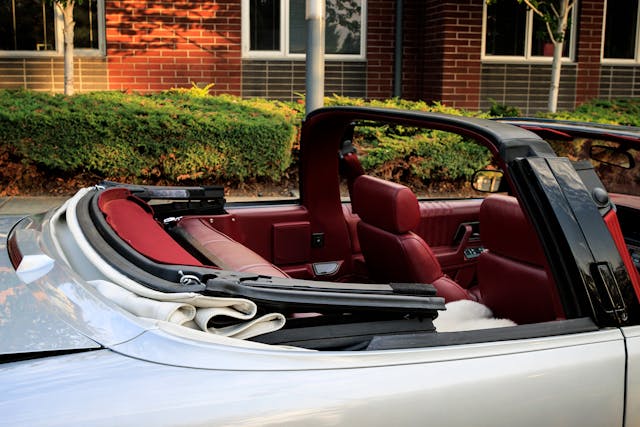
“One of the things I think is nicest about this car is that it’s a convertible with a meaningful back seat, which you rarely see now. I have a friend in Italy who has one of these Cutlass convertibles and he loves the car both for the style and the practicality. Plus, the top is fast. Sixteen seconds, I think?”
Mechanically, the cars were identical to the standard Cutlass coupe but 370 pounds heavier. They delivered the same competent and smooth but relaxed driving experience, although in 1990 and 1991 Oldsmobile started to add more punch to the coupe. The 140-hp 3.1-liter LHO V-6 was added for 1989, then 1990 brought the Quad-4 (160 or 180 hp), and in 1991 the 200-hp 3.4-liter LQ1 V-6 was made optional. Convertibles came only with the 3.1 or, after 1993, the 3.4.

The collector convertible
The Cutlass’s big wheelbase and usable back seat made it a rarity among convertibles in the early 1990s—and a hit with upper-middle-class buyers—with demand outstripping supply for much of the car’s run. In the summer of 1992, Olds marketing manager Lisa Crumley called the car “a real success story for Oldsmobile,” and sales soared from 1340 cars in 1991 to 8638 in 1994. Unfortunately, the story ended soon after.
Part of the problem was that GM had originally planned to build 250,000 Cutlasses a year at Doraville; it never managed more than 116,000. After years of running under capacity, production was moved to Fairfax, Kansas, in 1995, where the Pontiac Grand Prix was built, and the plant in Doraville was retooled for the GMT200-generation minivans. Moving convertible production was unfeasibly expensive, so it ended. Nobody could have known that it would be Oldsmobile’s last ragtop, but that anticlimactic end disguises the fact that collectors liked it from the start.
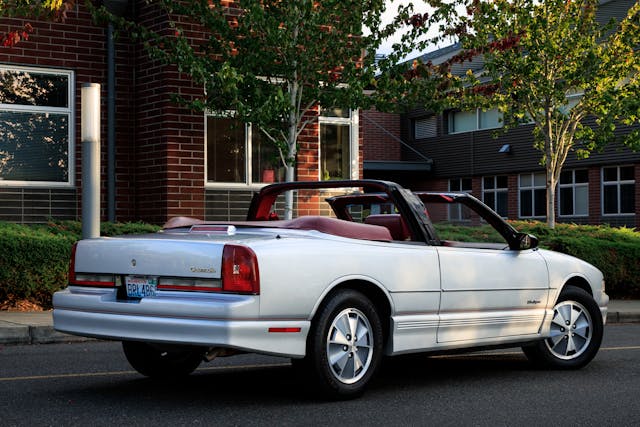
“We actually had two of them for a while,” says Ed Konsmo, owner of the silver ’91 featured here. An Olds collector since the 1980s, he started with a ’65 Cutlass convertible and currently also owns a 1950 98 Futuramic sedan, but the W-car’s cool styling and practicality were a big draw. “We bought our first one, a white ’92, in 2010, but later on a friend in the Olds club who owned this ’91 passed away, so my wife and I bought it.”
In the first two years, Cutlass Convertibles were not easy to get, and the original owner special ordered it and waited months for delivery, but rarely used it. It may be one of the nicest, most original examples in the world. “It’s one of only three in this color combo, and it had 17,000 miles on it when we got it three years ago. It’s a sunny day, date night kind of car.” Everything on the car is as it left Doraville and 100 percent original. Aside from the tires and a horn that doesn’t honk, it all operates like a new car.

Konsmo and the car got a warm reception at the 2022 Oldsmobile Nationals in Tennessee, but it draws lots of attention even at more casual events, taking “raddest in show” at the 2023 Radwood PNW event. He was surprised at the interest in the car from younger people, and also happy to learn that these Cutlasses and other post-1980 GM front-drivers are inspiring a thriving online fandom.
His message to fans who want to preserve this era of Olds history? “Get involved with clubs, they need you!”
***
Check out the Hagerty Media homepage so you don’t miss a single story, or better yet, bookmark it. To get our best stories delivered right to your inbox, subscribe to our newsletters.
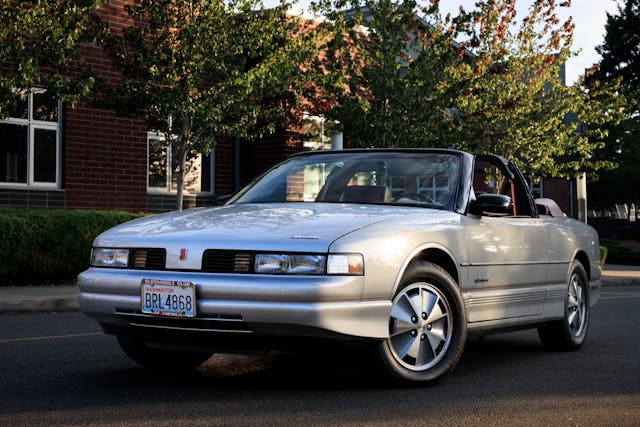
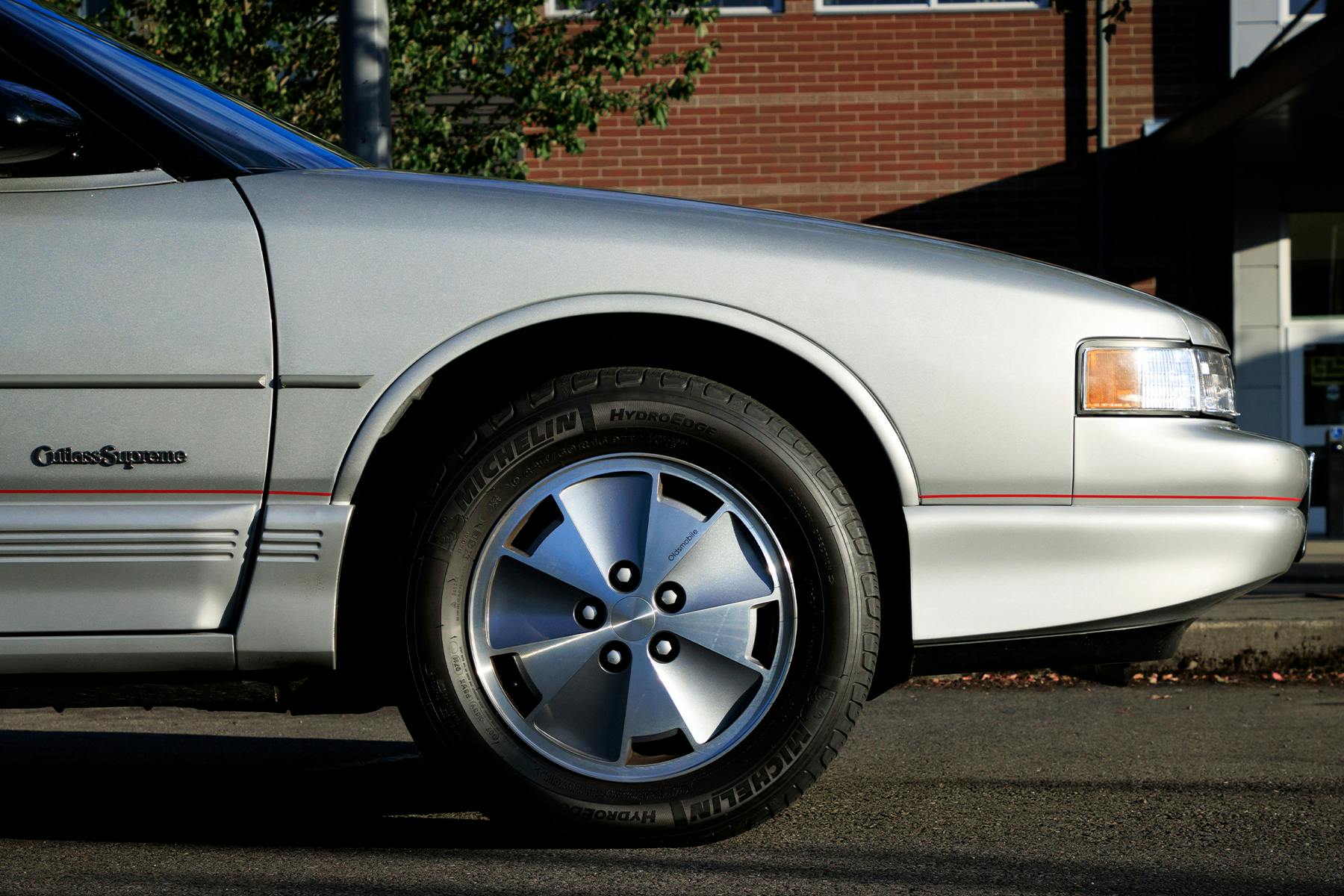
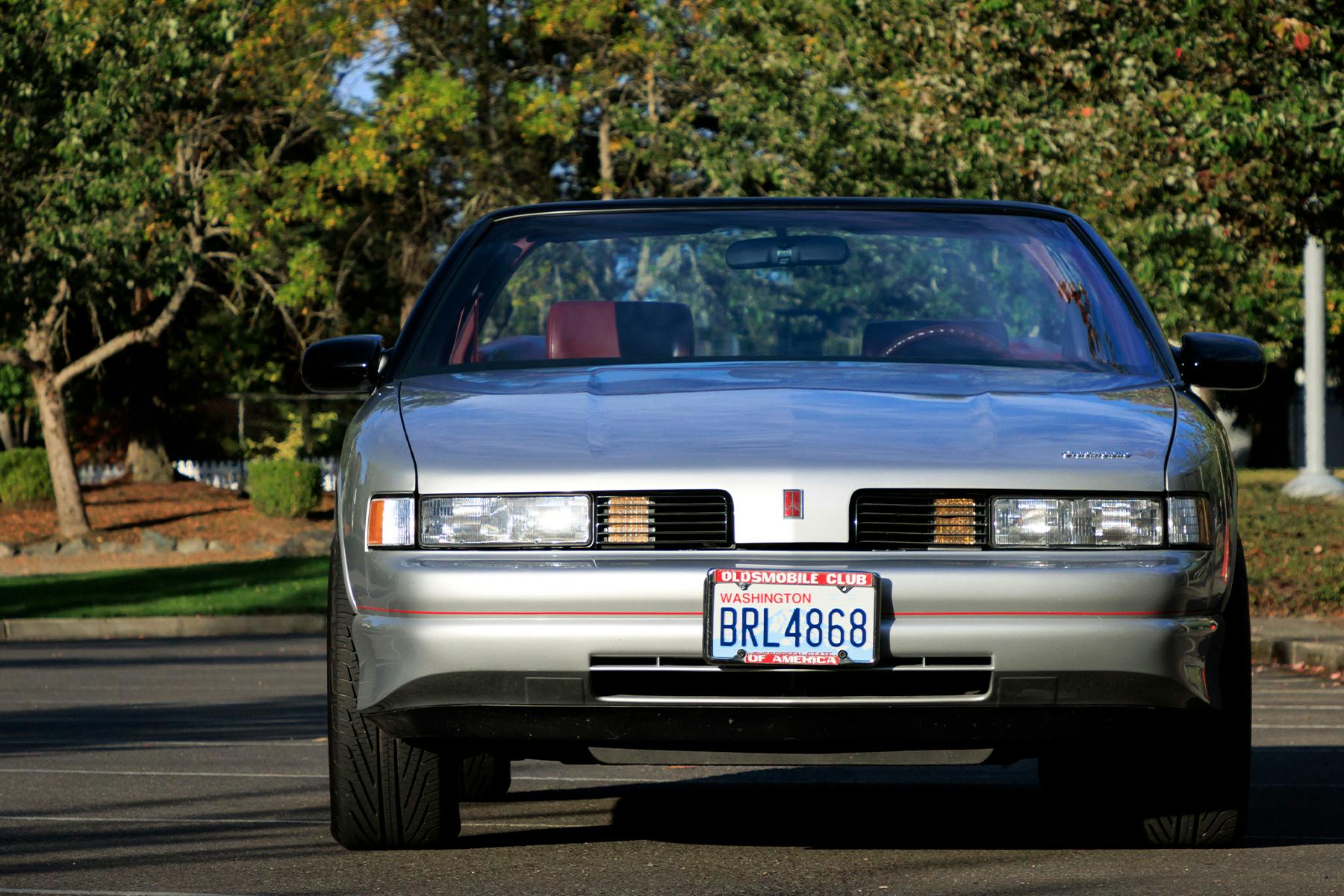
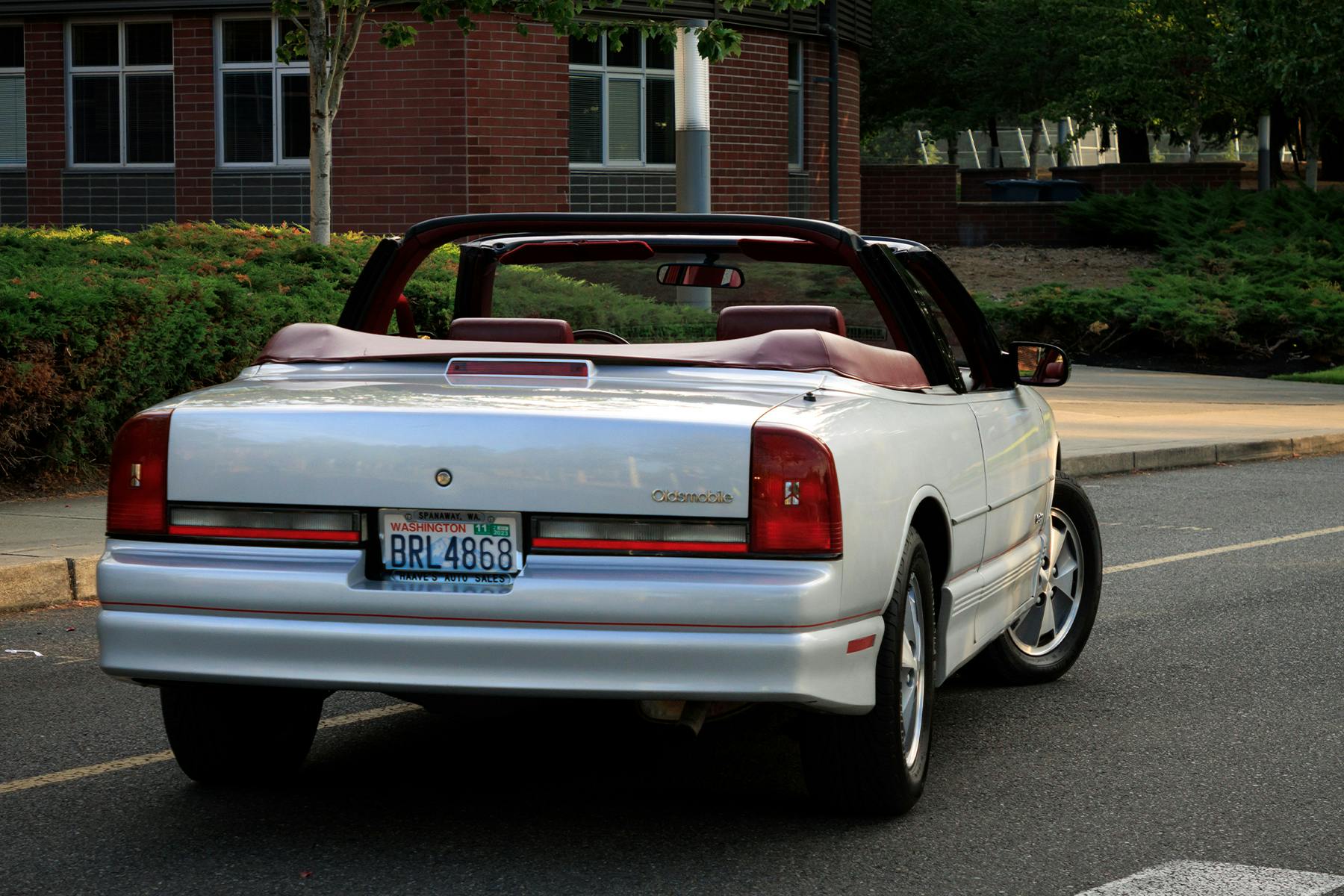
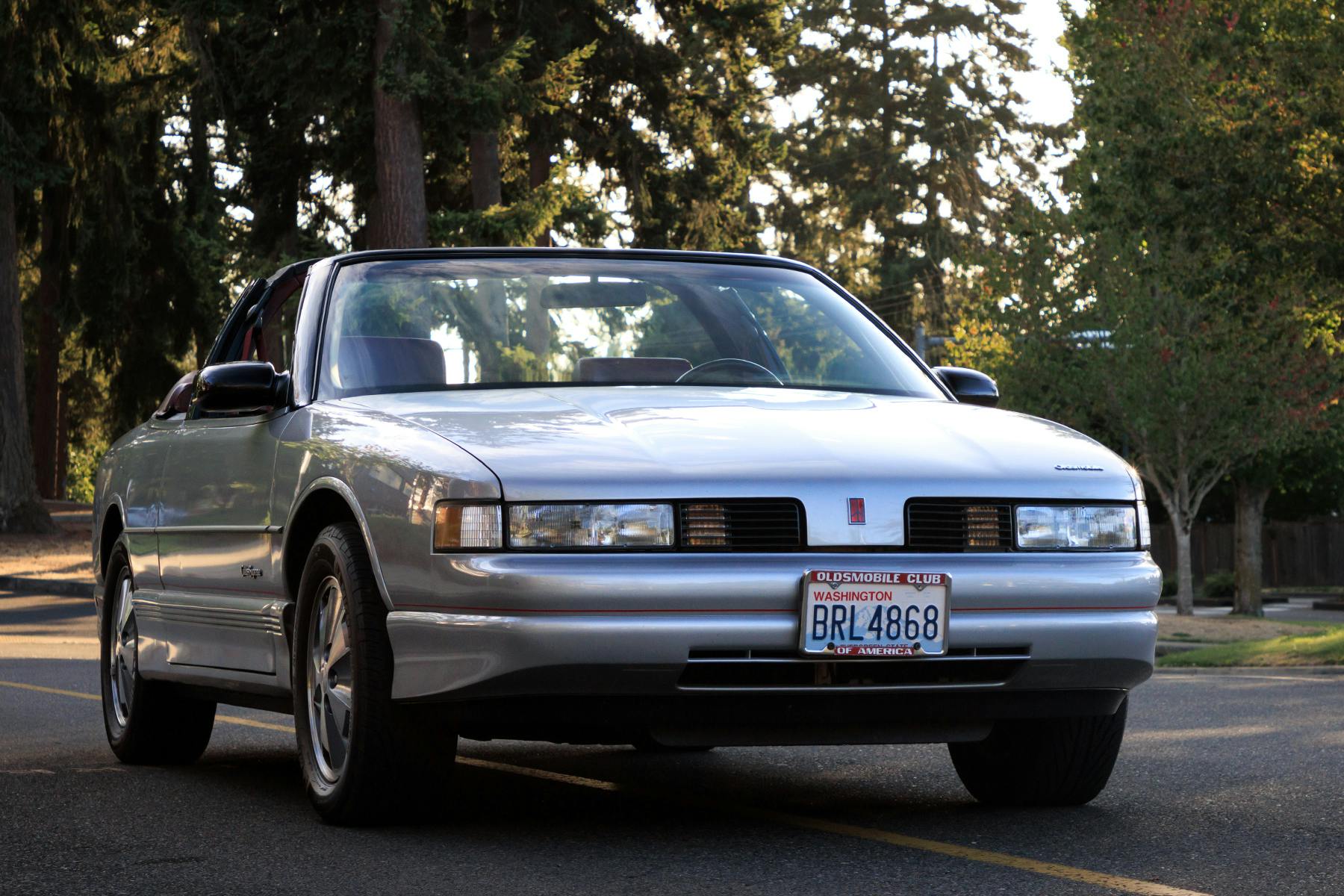
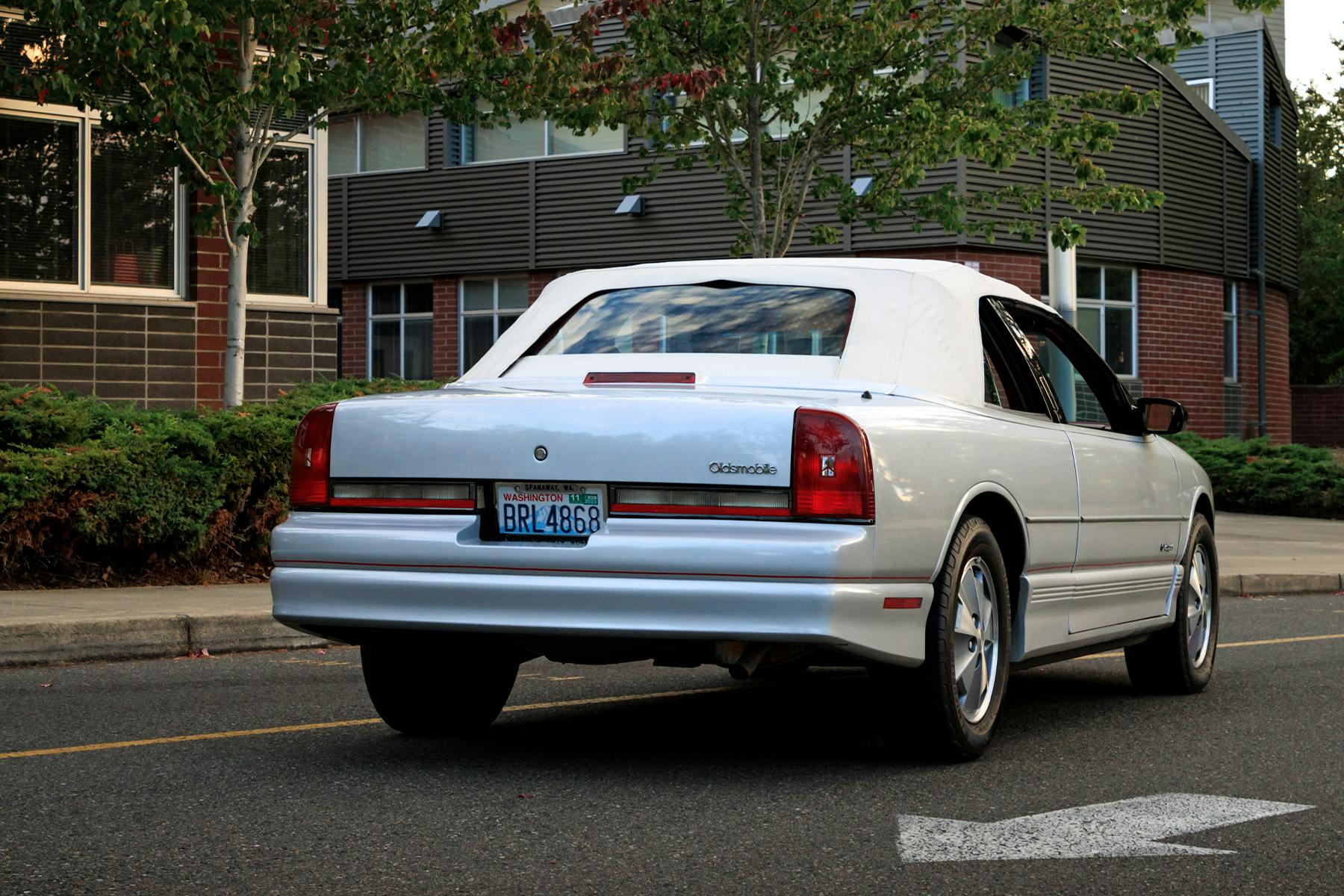



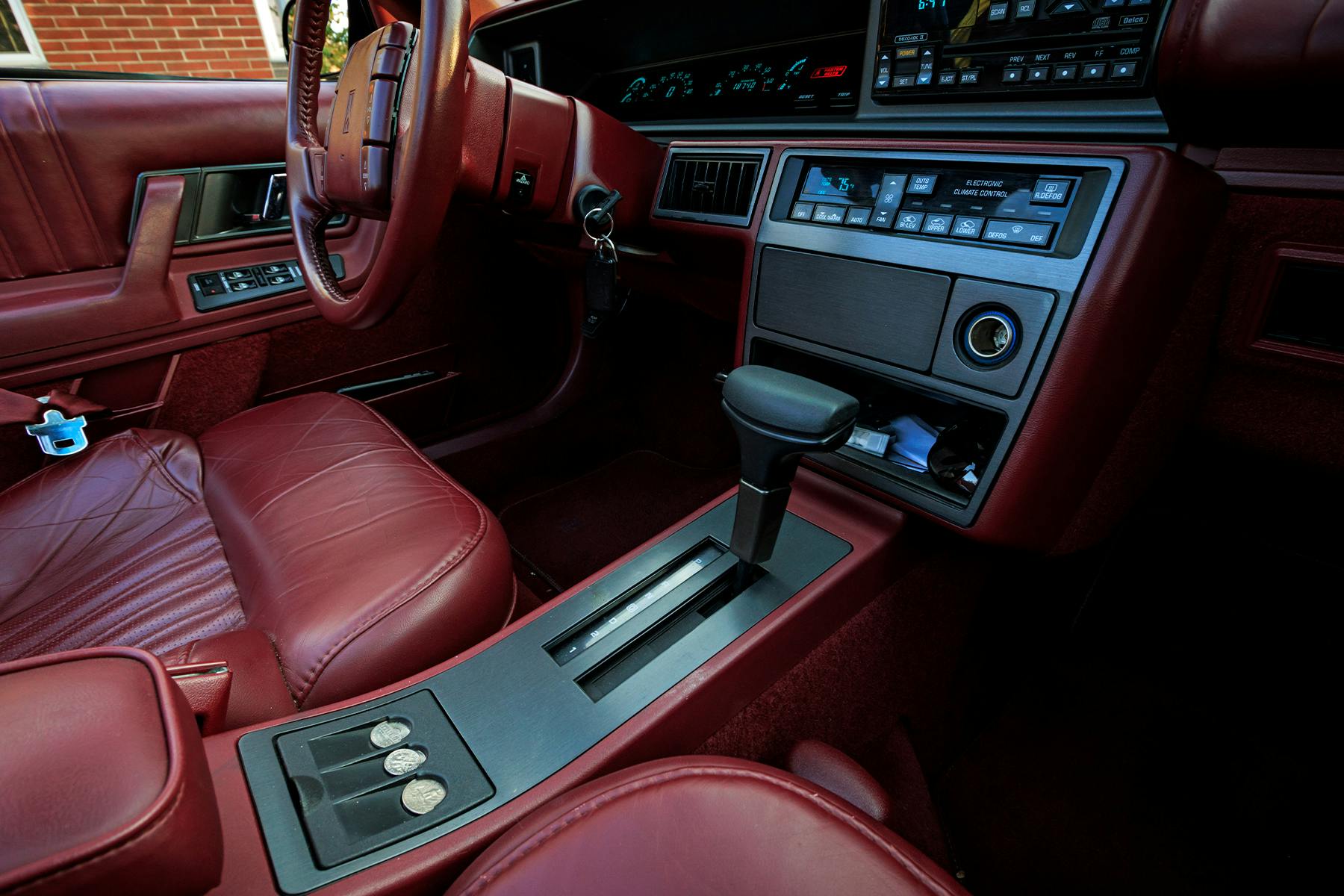


I’m not a convertible guy so I tend to prefer the coupes over it for the fixed roof look. These were good looking cars for the day. The front end still looks good.
I have always had a soft spot for these. Growing up, they were not common, but I always saw a guy driving a white one with red leather running around my town. I started to realize not only did he have 1 Cutlass Convertible but 2. They matched in color the only difference was the wheels, one had the later 5-spoke, the other the more common 4-door wheels.
A few years later, I became friends with the guy’s next-door neighbor and found out the story. He had bought a 93′ and a 94′ for his twin daughters for their first car. He wanted them to match when they went to school and parked next to each other of course the girls hated that idea!
I would like to find nice clean one but they have gotten hard to find now 30 years on.
I have a 1995 olds cutlass convertible. I am original owner and would like to sell. There are about 20,000 original miles. Only problem is small back windows do not go down. I was told that these cars were converted to convertible by a conversion company working with Oldsmobile and fixing these automatic windows might be complicated. The car is red with tan leather interior and tan top. It has been garage kept. It’s a little dusty and needs to be cleaned but otherwise great shape.
See reply to M
Where can buy this engine ?
This was the beginning of the end of Olds.
This was not a bad car but it was not the RWD car that supported Olds for years.
This car was part of the troubled W body that just never caught on.
I am glad people are saving these as most were used up and they are damn near impossible to restore.
The 90’s was a very troubled time at GM. In the 80’s Pontiac was targeted for closing but their performance models saved them. This put the target on Olds. Nothing they did help stop the target being moved to them.
This convertible is a good example of the engineers at GM trying to make the most of what they were given.
They should have put that front end on the 1988 parts car Cutlass Coupe G Body and jazzed it up as a NASCAR and promoted that with a 5.0 V8 500 HP. Engine, Possy Traction rear wheel drive and put a digital dashboard in it with either T-top roof or moon roof. The convertible top looked to cheesy for these cars period. That’s a car that would have sold out beyond demand. The price tag could have been enormous to a tune of 30K for that type of car for that year. Back then there was a lot of money still floating around the economy.
A 5.0L V8 with 500 HP in the 90s? Is there a supercharger too?
The BMW E39 M5 rolled out in 1999 with a naturally aspirated 4.9L V8 good for nearly 400hp with every fancy trick up it’s sleve to make it happen.
I think the Oldsmobile Cutlass Supreme Brougham Coupe G Body should make a new comeback. Make it the car it was supposed to be. Fast , gorgeous, classy, comfortable, sporty, reliable, durable, and stunningly beautiful. The G Body Coupe was one of the best looking cars ever built but never given it’s full potential. The 1988 leftover parts car with the 231 V6 2 barrel carborator and the 4 barrel carborator 307 V8 should have been built with a direct injection fuel engine for fast response with a mega 500 HP Engine. digital dashboard.
I love these cars. I had a 1995 Cutlass Supreme convertible. It was Torch Red with white leather and a white top. One of the best convertibles I have ever owned. The lease was up and I turned it back in, I regret doing that to this day I really should have brought it and kept it I really miss that car.
I have a 1995 olds cutlass convertible. I am original owner and would like to sell. There are about 20,000 original miles. Only problem is small back windows do not go down. I was told that these cars were converted to convertible by a conversion company working with Oldsmobile and fixing these automatic windows might be complicated. The car is red with tan leather interior and tan top. It has been garage kept. It’s a little dusty and needs to be cleaned but otherwise great shape.
I have a 1995 with 20,000 original miles. I am original owner and would like to sell. Red with tan leather interior and tan top. Garage kept.
“NOTHING LIKE AN OLDS”
I OWN A 93 CUTLASS SUPREME CONVERTIBLE WITH 63,000 ORIGINAL MILES, BRIGHT AQUA WITH BLACK TOP AND GRAPHITE LEATHER AND POLISHED 5 SPOKE WHEELS. THE INTAKE MANIFOLD GASKET WAS REPLACED THIS YEAR AND THE CAR CAR RUNS GREAT. DON OUVRY HAS 18 OF THESE CARS FOR PARTS. HIS NUMBER IS 989-225-7443 DECKER, MICHIGAN
these would’ve been better as rwd imo. I like the hoop – but hate the stupid seatbelt attached to the door thing. Not as bad as the toyota cressida’s that the shoulder belt would choke you if you tried getting out too fast, but still seems stupid – especially since the hoop is there – why not set the upper seatbelt on that?
i almost got one of these a few times and learned that one issue that had a creative fix – part of the door gasket that is unobtainable – you can swap a camaro gasket and cut it down to fit.
Reading this article brought back all the memories of building these cars, I worked at C&C for 10 years in the R&D department, and was part of developing both the pace cars and production version. I was also part of the building of multiple Olds concept cars, including a 1986 G-body that was to promote a next gen Hurst Olds with a manual trans & ground effects, it was a super clean design but GM canned it . At the time I had a 83 hurst olds that I puchased from C&C with a experamental 513 rear end , my boss let me cast a set of ground effects from the concept G-body , but I never got them installed, the motor went south and I sold the car. wish I still had it!!!!
All this went on while we were building the convertibles, I worked on every one of the pace cars (as I remember there were 35) and we were developing the production version at the same time , they were not engineered the same , the pace cars were very rough, but built to take a beating, the production version had more engineering…
This article really brought back all the work we were doing for Oldsmobile and GM at that time….
Great information, I recently purchased a 1990 Cutlass International Ciera coupe, w 26 k orig miles, have been showing it at local events. It is one of 411 built. Fun to drive. Not a Hurst / Olds, but very rare.
I drove a prototype of one of these cars at BOC Powertrain in Lansing back when Olds was working on the turbo and supercharged versions of the Quad 4. The Convertible Pace Car prototype had a supercharged Quad 4 that was making around 230 hp. It ran great. We were also working on the turbo Quad 4 and they were making 275-300 hp. We had a couple of Olds Toronado Trofeos as our test cars. They were 5 speed Getrag transaxles and were a lot of fun to drive. I was working at GM Research at the time and we were working on some cool programs back then. The trubo Quad 4 was also used in the AeroTech with Fueling Engineering doing some and C.J. Batten doing some work on them also.
Looks identical to my 91
I had a 93 Cutlass Convertible, it was a beautiful car, Teal color with black top and black interior but what a mechanical nightmare, mine had 210 horsepower dual overhead cam v6, front wheel drive. The convertibles were farmed out to a third party and I believe only came with the bigger v6 to make up for the extra 500 pounds of weight the top added, then a targa bar was added to shore up stability, while the targa bar did look cool its only function was to strengthen the body since there was no frame rail under the car, only sub frame up front with floor panels. Forget about replacing spark plugs with the engine sitting sideways in the car you can’t get to back 3 plugs with cylinder head right up against the firewall and heater core also inaccessible. The engine when it ran, ran very smooth and very responsive but nightmare to work on, not designed to last at all, as I recall it was a Lotus design with 2 very long timing chains to run cam shafts that had extremely poor designed tensioners that inevitably are designed to prematurely fail and cause chains to loosen and slip a gear and with a zero clearance on the piston it takes valves out. Lots of other electrical issues I had discovered in the 4 years I owned this car. Ended up trading it for a paint job on another car and be over it.